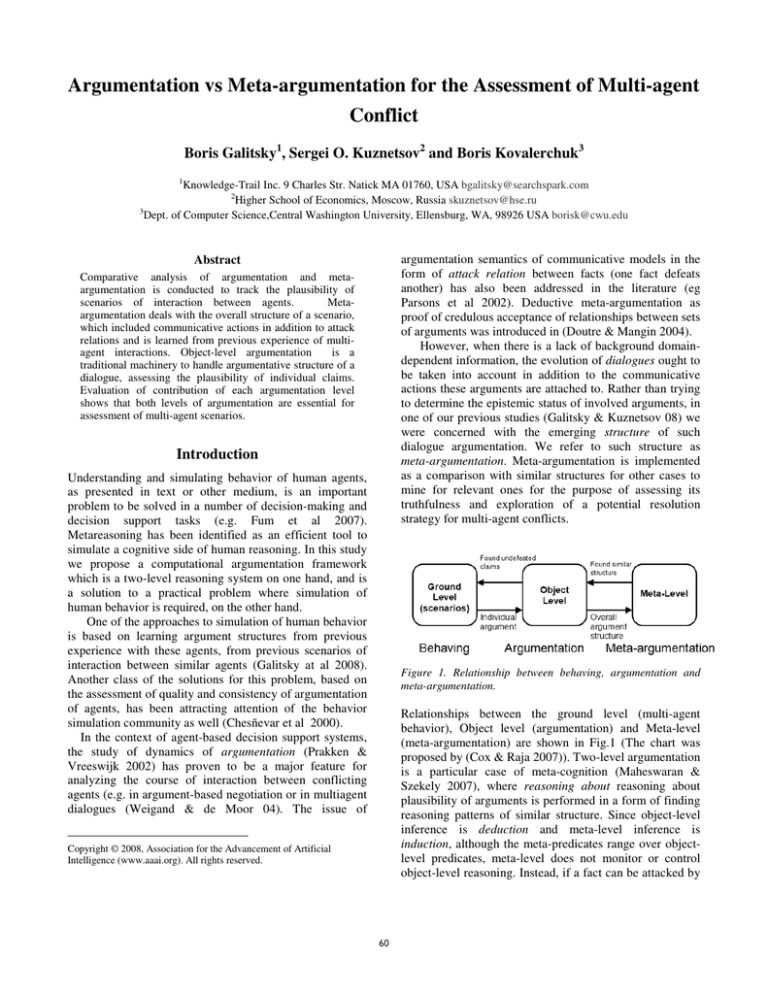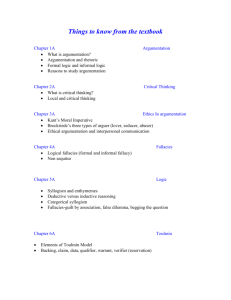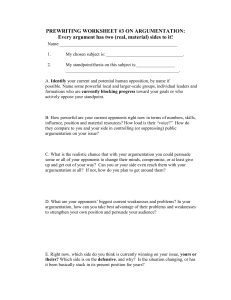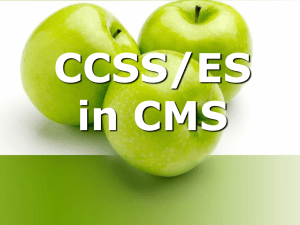
Argumentation vs Meta-argumentation for the Assessment of Multi-agent
Conflict
Boris Galitsky1, Sergei O. Kuznetsov2 and Boris Kovalerchuk3
1
Knowledge-Trail Inc. 9 Charles Str. Natick MA 01760, USA bgalitsky@searchspark.com
2
Higher School of Economics, Moscow, Russia skuznetsov@hse.ru
3
Dept. of Computer Science,Central Washington University, Ellensburg, WA, 98926 USA borisk@cwu.edu
argumentation semantics of communicative models in the
form of attack relation between facts (one fact defeats
another) has also been addressed in the literature (eg
Parsons et al 2002). Deductive meta-argumentation as
proof of credulous acceptance of relationships between sets
of arguments was introduced in (Doutre & Mangin 2004).
However, when there is a lack of background domaindependent information, the evolution of dialogues ought to
be taken into account in addition to the communicative
actions these arguments are attached to. Rather than trying
to determine the epistemic status of involved arguments, in
one of our previous studies (Galitsky & Kuznetsov 08) we
were concerned with the emerging structure of such
dialogue argumentation. We refer to such structure as
meta-argumentation. Meta-argumentation is implemented
as a comparison with similar structures for other cases to
mine for relevant ones for the purpose of assessing its
truthfulness and exploration of a potential resolution
strategy for multi-agent conflicts.
Abstract
Comparative analysis of argumentation and metaargumentation is conducted to track the plausibility of
scenarios of interaction between agents.
Metaargumentation deals with the overall structure of a scenario,
which included communicative actions in addition to attack
relations and is learned from previous experience of multiagent interactions. Object-level argumentation
is a
traditional machinery to handle argumentative structure of a
dialogue, assessing the plausibility of individual claims.
Evaluation of contribution of each argumentation level
shows that both levels of argumentation are essential for
assessment of multi-agent scenarios.
Introduction
Understanding and simulating behavior of human agents,
as presented in text or other medium, is an important
problem to be solved in a number of decision-making and
decision support tasks (e.g. Fum et al 2007).
Metareasoning has been identified as an efficient tool to
simulate a cognitive side of human reasoning. In this study
we propose a computational argumentation framework
which is a two-level reasoning system on one hand, and is
a solution to a practical problem where simulation of
human behavior is required, on the other hand.
One of the approaches to simulation of human behavior
is based on learning argument structures from previous
experience with these agents, from previous scenarios of
interaction between similar agents (Galitsky at al 2008).
Another class of the solutions for this problem, based on
the assessment of quality and consistency of argumentation
of agents, has been attracting attention of the behavior
simulation community as well (Chesñevar et al 2000).
In the context of agent-based decision support systems,
the study of dynamics of argumentation (Prakken &
Vreeswijk 2002) has proven to be a major feature for
analyzing the course of interaction between conflicting
agents (e.g. in argument-based negotiation or in multiagent
dialogues (Weigand & de Moor 04). The issue of
Figure 1. Relationship between behaving, argumentation and
meta-argumentation.
Relationships between the ground level (multi-agent
behavior), Object level (argumentation) and Meta-level
(meta-argumentation) are shown in Fig.1 (The chart was
proposed by (Cox & Raja 2007)). Two-level argumentation
is a particular case of meta-cognition (Maheswaran &
Szekely 2007), where reasoning about reasoning about
plausibility of arguments is performed in a form of finding
reasoning patterns of similar structure. Since object-level
inference is deduction and meta-level inference is
induction, although the meta-predicates range over objectlevel predicates, meta-level does not monitor or control
object-level reasoning. Instead, if a fact can be attacked by
Copyright © 2008, Association for the Advancement of Artificial
Intelligence (www.aaai.org). All rights reserved.
60
In our simplified model of communication semantics
(Galitsky 2006) communicative actions will be
characterized by three parameters: (1) agent name, (2)
subject (information transmitted, an object described, etc.),
and (3) cause (motivation, explanation, etc.) for this
subject. When representing scenarios as graphs, we take
into account all these parameters. Different arc types bear
information whether the subject stays the same or not.
Thick arcs link vertices that correspond to communicative
actions with the same subject, whereas thin arcs link
vertices that correspond to communicative actions with
different subjects.
We will make explicit conflict
situations in which the cause of one communicative action
M1 “attacks” the cause or
subject of another
communicative action M2 via an argumentation arc A (or
argumentation link) between the vertices for these
communicative actions. This attack relationship expresses
that the cause of first communicative action (“from”)
defeats the subject or cause of the second communicative
action (“to”). Such defeat relationship is defeasible, as it
may be subject to other defeats, as we will see later.
A pair of vertices for a thick or thin arc may or may not
be linked by the attack relation: a subject of the first
communicative action is supported by a cause for the same
(respectively, different) subjects of the second
communicative action. However, we are concerned with
argumentation arcs which link other than consecutive
vertices (communicative actions) as shown at Fig. 2.
For the sake of example, consider the text given below
representing a complaint scenario in which a client is
presenting a complaint against a company because he was
charged with an overdraft fee which he considers to be
unfair. We denote both parties in this complaint scenario as
Pro and Con (proponent and opponent), to make clear the
dialectical setting. In this text communicative actions are
shown in bold. Some expressions appear underline,
indicating that they are defeating earlier statements. Fig. 3
shows the associated graph, where straight thick and thin
arcs represent temporal sequence, and curve arcs denote
defeat relationships.
Note that first two sentences (and the respective
subgraph comprising two vertices) are about the current
transaction (deposit), three sentences after (and the
respective sub-graph comprising three vertices) address the
unfair charge, and the last sentence is probably related to
both issues above. Hence the vertices of two respective
subgraphs are linked with thick arcs: explain-confirm and
remind-explain-disagree. It must be remarked that the
underlined expressions help identify where conflict among
arguments arise. Thus, the company’s claim as disclosed
in my account information defeats the client’s assertion due
to a bank error. Similarly, the expression I made a deposit
well in advance defeats that it usually takes a day to
process the deposit (makes it non-applicable). The former
defeat has the intuitive meaning “existence of a rule or
criterion of procedure attacks an associated claim of an
other non-defeated facts, no meta-reasoning is required to
observe that the scenario is invalid. If no such attack is
found, meta-argumentation is used to verify if there are
similar valid or invalid scenarios. Having found such
similarity and having a particular fact defeated, metaargumentation can give control to the object–level
argumentation to operate with additional information. In
this study we explore a simplified model where both levels
of argumentation acts independently.
In our earlier studies we proposed a concept learning
technique for scenario graphs, which encode information
on the sequence of communicative actions, the subjects of
communicative actions, the causal (Galitsky et al 05), and
argumentation attack relationships between these subjects
(Galitsky et al 08). Scenario knowledge representation and
learning techniques were employed in such problems as
predicting an outcome of international conflicts,
assessment of an attitude of a security clearance candidate,
mining emails for suspicious emotional profiles, and
mining wireless location data for suspicious behavior
(Galitsky et al 07).
In this study we perform a comparative analysis of the
two levels of argumentation-related information mentioned
above to assess plausibility of scenarios of interaction
between agents.
The meta-level of information on
argumentation is an overall structure of a scenario, which
included communicative actions in addition to attack
relations and is learned from previous experience of multiagent interactions. Scenarios are represented by directed
graphs with labeled vertices (for communicative actions)
and arcs (for temporal and causal relationships between
these actions and their parameters) (Galitsky et al 05). The
object-level is a traditional machinery to handle
argumentative structure of a dialogue, assessing the
plausibility of individual claims, which has been a subject
of multiple applied and theoretical AI studies.
Meta-argumentation in dialogue
We approximate an inter-human interaction scenario as a
sequence of communicative actions (such as inform, agree,
disagree, threaten, request), ordered in time, with attack
relation between some of the subjects of these
communicative language. Scenarios are simplified to allow
for effective matching by means of graphs. In such graphs,
communicative actions and attack relations are the most
important component to capture similarities between
scenarios. Each vertex in the graph will correspond to a
communicative action, which is performed by an
(artificial) agent. As we are modeling dialogue situations
for solving a conflict, we will borrow the terms proponent
and opponent from dialectical argumentation theory
(Prakken & Vreeswijk 2002) to denote such agents. An arc
(oriented edge) denotes a sequence of two actions.
61
form ((V,l),(E,b)), where V is a set of vertices, E is a set of
Λς is a function assigning labels to vertices,
edges, l: V
and b: E
ΛΕ is a function assigning labels to edges.
The order is defined as follows: For two graphs 1:=
((V1,l1),(E1,b1)) and 2:= ((V2,l2),(E2,b2)) from G we say
that 1 dominates 2 or 2
1 (or 2 is a subgraph of 1)
V1 such that it
if there exists a one-to-one mapping : V2
• respects edges: (v,w) ∈ E2
( (v), (w)) ∈ E1,
• fits under labels: l2(v l1( (v)), (v,w) ∈ E2
error”, and the latter defeat has the meaning “the rule of
procedure is not applicable to this particular case”.
b2(v,w)
b1( (v), (w)).
This definition allows generalization (“weakening”) of
labels of matched vertices when passing from the “larger”
graph G1 to “smaller” graph G2.
Now, generalization Z of a pair of scenario graphs X
and Y (or their similarity), denoted by X ∗ Y = Z, is the set
of all inclusion-maximal common subgraphs of X and Y,
each of them satisfying the following additional
conditions:
• To be matched, two vertices from graphs X and Y
must denote communicative actions of the same
agent;
• Each common subgraph from Z contains at least
one thick arc.
The following conditions hold when a scenario graph U is
assigned to a class:
1) U is similar to (has a nonempty common scenario
subgraph of) a positive example R+. It is possible that the
same graph has also a nonempty common scenario
subgraph with a negative example R- . This is means that
the graph is similar to both positive and negative examples.
2) For any negative example R-, if U is similar to R- (i.e.,
U ∗ R-≠∅) then U ∗ R- μ U ∗ R+. This condition introduces
the measure of similarity and says that to be assigned to a
class, the similarity between the unknown graph U and the
closest (in terms of μ) scenario from the positive class
should be higher than the similarity between U and each
negative example (i.e., representative of the class of
implausible complaints).
Graph language is quite convenient to formalize the
dialogues. However, to better show how the object level is
related to the meta-level, we can represent both levels in a
predicate language.
In the object level, we perform deduction with
predicates attackRelation(Fact1, Fact2) to assess the
validity of individual facts. Graph-based concept learning,
expressed in predicate language, would include such
predicates as
graph_edge(AttackRelation1(Fact11, Fact21),
AttackRelation2((Fact21, Fact22)).
The scenario is then an ordered sequence of such
expression, and a minimal common sub-scenario is the
least general generalization operation of anti-unification.
(Galitsky
&
Kuznetsov
2008)
presents
the
metaprogramming technique for learning scenarios as logic
Figure 2: A conflict scenario with attack relations.
Our task is to classify (for example, by determining its
plausibility) a new complaint scenario without background
knowledge, having a dataset of scenarios for each class.
We intend to automate the above analysis given the formal
representation of the graph (obtained from a user-company
interaction in the real world, filled in by the user via a
special form where communicative actions and
argumentation links are specified).
explain
confirm
remind
disagree
explain
deny
Figure 3: The graph for approximated scenario (Fig. 2).
Let us enumerate the constraints for the scenario graph:
1) All vertices are fully ordered by the temporal
sequence (earlier-later);
2) Each vertex is either assigned with the proponent
(drawn on the left side of each graph in Fig. 3) or to
the opponent (drawn on the right side).
3) Vertices denote actions either of the proponent or of
the opponent;
4) The arcs of the graph are oriented from earlier
vertices to later ones;
5) Thin and thick arcs point from a vertex to the
subsequent one in the temporal sequence (from the
proponent to the opponent or vice versa);
6) Curly arcs, staying for attack relations, jump over
several vertices in either direction.
Similarity between scenarios is defined by means of
maximal common subscenarios. Since we describe
scenarios by means of labeled graphs, we outline the
definitions of labeled graphs and domination relation on
them (see Kuznetsov 1999). Given ordered set G of graphs
(V,E) with vertex- and edge-labels from the sets (Λς, and
(ΛΕ, ). A labeled graph from G is a quadruple of the
62
programs, where the operation of anti-unification was
adjusted to deal with conflict scenarios.
Using anti-unification requires associativity in finding
similarity between scenarios: (S1 ∩ S2) ∩ S3 = S1 ∩ (S2 ∩
S3). Applying anti-unification to scenarios as ordered lists
of expressions for communicative actions does not obey
the associativity. A naive solution here would be to ignore
the order of communicative actions and just consider
conjunctions of expressions for these actions. This would
lead to ignorance of essential information about scenarios.
To overcome this problem we represent the ordered set
of formulas for communicative actions as the unordered set
of these action plus multiple instances of the binary
predicate
after(Action1,
Action2)
and
attackRelation(Fact1, Fact2), where Fact1 and Fact2 are
the subjects of Action1 and Action2 respectively. Using
this predicate allows retaining information about the order
of communicative actions in scenario and obeying the
associativity at the same time. To find a common scenario
formula for two scenarios, which are represented by
formulas above, we separately match predicates for
communicative actions, predicates for their order of actions
after and attack predicates. The role for scenario
classification of a sequence of communicative actions
forming a step is more important than the role of a single
communicative action. Therefore, computing similarity
between scenarios, one primarily needs to find matching
steps occurring in a pair of scenarios and then search for
matching individual actions.
I'm constantly bombarded with calls from Huntington about
this so called delinquency which culminated in a threat from
Huntington collections to repossess my truck and other vehicle
(both loan items)
When I explained that I had been paying the loans by check
AND that those checks had been debited from my other bank
account, they continued to insist that no payments had been
applied to either account and that Huntington was still going to
repossess my vehicles. Discussion with them caused me to
look closer at my records and I've found corresponding checks
that have posted from my primary, non-Huntington account.
It does appear, however, that one payment for $181.62 was
never posted. After this, I again called Huntington and
explained the situation. I was told that as long as Huntington
had an open account for me, from which they'd already set up
automatic withdraw, they could continue to withdraw funds for
loan payment, even if the loan had already been paid by check!
I was also informed that the best way to rectify the situation
was to close the Huntington account.
Since getting my loan, I've had continuing trouble. The first
payment was late, due to a mistake made by Huntingtonwhich they acknowledged. Huntington told me that they'd take
the late payment off my record but it appears they never did.
All in all, banking with Huntington has been a complete fiasco.
I've been a loyal customer for over 21 years and expected to be
treated with some amount of respect. Instead, I've been treated
like a liar and made to feel that the responsibility in resolving
this problem lies only on my shoulders.
Figure 4: Full complaint scenario
ask
*
Assessing defeasibility of individual claims
ignore
To verify the truthfulness of a complainant’s claim, we use
the special form called Interactive Argumentation Form
which assists in structuring a complaint. Use of this form
enforces a user to explicitly indicate all causal and
argumentation links between statements which are
included in a complaint. The form is used at the objectlevel argumentation to assess whether a particular scenario
has plausible argumentation pattern: does it contain selfattacks (explicit for the complainant).
*
request
ignore
threat
*
explain
disagree
insist
threaten
Beginning in July of 2003, I began using a non-Huntington
account as my primary checking
agree
*
I have 2 loans through Huntington, both of which were
automatically deducted at the appropriate times each month
from my Huntington account. At the beginning of July, I began
paying those loans by check from the non-Huntington account.
Though I had attempted to stop Huntington from taking the
funds directly from my Huntington account, they continued to
do so resulting in a continuing negative balance, compounded
by NSF and overdraft fees, as well as the initial debit for the
loans. Calls to Huntington regarding the matter have had no
effect.
inform
*
request
ask
promise
ignore
Figure 4a: Scenario graph for the above complaint (Fig. 4).
63
To specify supporting and defeating links for a number
of statements for each section, multiple instances of these
forms may be required for a given complaint. Since even
for a typical complaint manual consideration of all
argumentation links is rather hard, automated analysis of
inter-connections between the complaint components is
desired. We use the defeasible logic programming
approach to verify whether the complainant’s claims are
plausible (cannot be defeated given the available data).
We enumerate the attack relations in the scenario
The fact that the first payment was late is accepted to be a
mistake <What company accepted> ĺ wrong late payment fee
<Company wrongdoing>
The customer was charged the insufficient fund fee <How it
harmed me> ĺ it becomes clear how the bank makes money
when customer claims that the bank always uses direct debit and
no other way of loan payment is accepted <How company
explained>.
The customer claims that the bank always uses direct debit
<How company explained> ĺ the bank cannot cancel direct
debit without closing account <Systematic wrongdoing>
Making the mistake concerning charge for the first late
payment <What company accepted> ĺ not taking responsibility,
in customer’s opinion <Systematic wrongdoing>.
The customer perceives himself as a loyal one (for over 21
years) <Why I think this was wrong> ĺ Making the mistake
concerning charge for the first late payment <What company
accepted>.
One processed check <What company accepted> ĺ Processed
both direct deposit and check of another bank <Company
wrongdoing>.
Processed both direct deposit and check of another bank
<Company wrongdoing> ĺ less amount than expected in the
checking account <commonsense> ĺ negative balance in this
account <commonsense> ĺ insufficient fee <How it harmed
me>.
Advised to close account <What company accepted> ĺother
banks are able to cancel direct deposit orders <Where company
got confused>
Figure 5: Interactive Argumentation Form
The form (Fig. 5) includes eight input areas where a
complainant presents a component-based description of a
problem (Fig.4). At the beginning, the subject of the
dispute is specified: an operation (or a sequence of
operations) which are believed by a complainant to be
performed by a company in a different manner to what was
expected <Where company got confused>. Then the
essence of the problem is described, what exactly turned
out to be wrong. In the section <Company wrongdoing>
the complainant sketches the way the company performed
its duties, which caused the current complaint. The
customer’s perception of the damage is inputted in section
<How it harmed me>. In the fourth section <Why I think
this was wrong> the customer backs up his beliefs
concerning the above two sections, <Where company got
confused> and <Company wrongdoing>.
All possible object-level argumentation links are shown
as arrows. Arrows denote the links between the sentences
in the respective sections; some arrows go one way and
other both ways (only the ending portion is shown in this
case). If the user does not find an arrow between two
sections for a pair of inputted sentences, it means that
either or both of these sentences belong to a wrong section:
the data needs to be modified to obey the pre-defined
structure. End of each arrow is assigned by a check-box to
specify if the respective link is active for a given complaint
Dialectic trees for implicit self-attacks
In this section we provide the definition and algorithm for
building dialectic trees to discover implicit self attack in a
defeasible logic program, specified by the Interactive
Argumentation Form (Figure 5).
Defeasible logic program (de.l.p.) is a set of facts,
strict rules Π of the form (A:-B) , and a set of defeasible
rules Δ of the form (A>-B). Let P=(Π, Δ) be a de.l.p. and
L a ground literal. A defeasible derivation of L from P
consists of a finite sequence L1, L2, . . . , Ln = L of ground
literals, and each literal Li is in the sequence because:
(a) Li is a fact in Π, or
(b) there exists a rule Ri in P (strict or defeasible) with head
Li and body B1,B2, . . . ,Bk and every literal of the body is
an element Lj of the sequence appearing before Lj (j < i).
. Bold arrows denote most important links
.
The role of the Interactive Argumentation Form is a
visual representation of argumentation, and intuitive
preliminary analysis followed by the automated
argumentation analysis. Since even for a typical complaint
manual consideration of all argumentation links is rather
hard, automated analysis of inter-connections between the
complaint components is desired. We use the defeasible
logic programming (García and Simari 2004) approach to
verify whether the complainant’s claims are plausible
(cannot be defeated given the available data), concluding
with the main claim, Systematic wrongdoing.
64
Let h be a literal, and P=(Π, Δ) a de.l.p.. We say that <A,
h> is an argument structure for h, if A is a set of defeasible
rules of Δ, such that:
1. there exists a defeasible derivation for h from =(Π ∪
A);
2. the set (Π ∪ A) is non-contradictory, and
3. A is minimal: there is no proper subset A0 of A such that
A0 satisfies conditions (1) and (2).
Hence argument structure <A, h> is a minimal noncontradictory set of defeasible rules, obtained from a
defeasible derivation for a given literal h.
We say that <A1, h1> attacks <A2, h2> iff there exists a
sub-argument <A, h> of <A2, h2> (A ⊆A1) so that h and h1
are inconsistent. Argumentation line is a sequence of
argument structures where each element in a sequence
attacks its predecessor. There is a number of acceptability
requirements for argumentation lines (Garcia & Simari 03).
We finally approach the definition of dialectic tree
which gives us an algorithm to discover implicit self-attack
relations in users’ claims. Let <A0, h0> be an argument
structure from a program P. A dialectical tree for <A0, h0>
is defined as follows:
1. The root of the tree is labeled with <A0, h0>
2. Let N be a non-root vertex of the tree labeled <An, hn>
and
Λ= [<A0, h0>, <A1, h1>, …, <An, hn>] the sequence of
labels of the
path from the root to N. Let [<B0, q0>, <B1, q1>, …, <Bk,
qk>] all attack
<An, hn>. For each attacker <Bi, qi> with acceptable
argumentation line [Λ,<Bi, qi>], we have an arc between N
and its child Ni .
In a dialectical tree every vertex (except the root)
represents an attack relation to its parent, and leaves
correspond to non-attacked arguments. Each path from the
root to a leaf corresponds to one different acceptable
argumentation line. As shown in Fig.7, the dialectical tree
provides a structure for considering all the possible
acceptable argumentation lines that can be generated for
deciding whether an argument is defeated. This tree is
called dialectical because it represents an exhaustive
dialectical analysis for the argument in its root, which is
systematic wrongdoing of a company, the conclusion we
want to draw or reject as a result of our analysis.
<A, systematic_wrongdoing1>
<B3, ~why_wrng1>
<B1, ~why_wrng1>
<B2, ~why_wrng1>
<C1, ~unclear1>
<C2, ~unclear1>
<D1, ~company_wrongdoing2>
Figure 7: Dialectic tree for the Defeasible Logic Program Fig. 8.
For the defeasible logic program specified via the form, the
dialectic tree shows that the main claim (the entry point) of
the form is self-defeated, therefore complainants’ claim of
systematic company wrongdoing is not plausible.
Evaluation
systematic_wrongdoing1(X) -< why_wrng1(X).
why_wrng1(X) -< how_it_harmed1(X).
how_it_harmed1(‘reposses my track’).
~ why_wrng1(X). -< how_it_harmed1(X1),
company_accepted1 (X2).
company_accepted 1(‘one check processed’).
~ why_wrng1(X) -< comp_confused1(X).
comp_confused1(‘proc loan payment’).
~ unclear1(X)-< company_accepted2 (X1),
company_wrongdoing2(X2).
company_wrongdoing2(X) -< how_it_harmed2(X).
how_it_harmed2(‘overdraft fees’). ~ why_wrng1(X)-<
how_it_harmed1(X1), unclear1(X2).
unclear1(X)-< company_accepted2 (X).
company_accepted2 (‘advised to close account’).
company_accepted3 (‘1st payment late - mistake’).
~ unclear1(X)-<how_company_explained(X).
how_company_explained(‘always use direct debit’).
~ company_wrongdoing2(X) -< company_accepted3 (X).
To observe the comparative contribution of argumentation
in object-level and meta-level, we used the database of
textual complaints which were downloaded from the public
website PlanetFeedback.com during three months starting
from March 2004 and used in a number of computational
studies since then. For the purpose of this evaluation, each
complaint was:
1) manually assigned a plausibility assessment;
2) manually represented at a meta-level for machine
learning evaluation;
3) manually represented as an object level for finding
self-defeating claims.
We consider a complaint to be plausible if it seems to be
consistent: no self-defeating is found, and implausible, if
defeat is found (at either object-level or metalevel).
Not all complaints submitted by upset customers to
consumer advocacy websites can be assessed with respect
to plausibility. Clearly, the plausibility of those complaints
just mentioning a failure in a product or a service without
describing any interaction with the customer support
cannot be assessed using the proposed technique.
Figure 6: Defeasible logic program for a fragment of Interactive
Argumentation Form on Fig. 5.
65
This complaint preprocessing resulted in 560
complaints, divided in fourteen banks (or datasets), each of
them involving 40 complaints. In each bank 20 complaints
were used for training and 20 complaints for evaluation.
We performed the comparative analysis of relating
scenarios to the classes of plausible/implausible taking into
account 1), 2), and combined (1+2) . Such an analysis
sheds a light on the possibility to recognize a scenario (1)
without background knowledge, but reusing previous
assigned argument structures, and (2) with partial
background knowledge, expressed as a set of attack
relations between claims. Furthermore, we evaluate a
cautious approach combining 1) and 2), where scenario is
plausible if a) it is similar to a plausible one or b) it does
not contain self-defeated claims, and implausible
otherwise.
Classification results are shown in Table1. On the left,
the first three columns contain bank number, and the
numbers of plausible/implausible complaints as manually
assessed by human experts. The middle set of columns
show the classifications results based on 1) & 2) together
(separate 1) and 2) classification results are shown in
appendix).
Results and discussions
7.86 12.1 8.4 10 1.071 1.857 89%
F-measure
Precision plausible
100%
70%
82%
75%
100%
78%
100%
90%
100%
77%
100%
86%
100%
90%
Recall implausible
1
6
2
1
2
2
0
3
2
1
2
2
1
1
Recall plausible
0
3
2
2
0
2
0
1
0
3
0
1
0
1
Precision
implausible
11
8
11
14
10
10
9
9
11
10
8
13
9
11
implausible but
implausible
8
6
7
5
8
8
11
8
7
9
10
5
10
8
12
14
13
15
12
12
9
12
13
11
10
15
10
12
8
7
9
6
8
7
11
9
7
10
10
6
10
9
Cimplausible
ass ed as
plausible but
implausible
Not
Classified as
implausible
Cclassified as
plausibleas
Classified
1
2
3
4
5
6
7
8
9
10
11
12
13
14
avg
plausible
Bank
As
Results of classification: both levels
assigned
by experts
92%
57%
85%
93%
83%
83%
100%
75%
85%
91%
80%
87%
90%
92%
100%
88%
82%
86%
100%
117%
100%
90%
100%
91%
100%
86%
100%
90%
92%
57%
85%
93%
83%
83%
100%
75%
85%
91%
80%
87%
90%
92%
96%
69%
83%
89%
91%
97%
100%
82%
92%
91%
89%
86%
95%
91%
85%
95%
85% 89%
Table 1. Results of the combined classification.
Classification based on the combination of levels gives
substantial increase in recognition accuracy: F(1)= 63%,
F(2) = 77%, and F(1+2)= 89%, which is a 26% of increase
of accuracy for (1) and 12% increase of the accuracy for
(2).
66
In this study we observed how two levels of
argumentation, overall argumentation pattern of a scenario
and dialectic trees for individual claims, complement each
other. Comparative computational analysis of scenario
classification with respect to plausibility showed that both
levels of argumentation (the former proposed in the current
study, and the latter well known in various reasoning
domains) are essential to determine whether a scenario is
plausible or not (contains misrepresentation or selfcontradiction). Hence we believe a practical argumentation
management system should include scenario-oriented
machine learning capability in addition to handling
argumentation for individual claims.
Our approach can be related to metareasoning as a twolevel system, however it is not a deductive metareasoning
system. The object-level system is deductive, and the metalevel is inductive. Hence the proposed two-level system
can be referred to as metareasoning in the same sense as
induction is considered reasoning.
Graph-based
concept
learning
benefits
from
argumentation information in the form of dialectic tree,
because a representation graph G includes more sensitive
data on how claims are attacking each other:
G = { Communicative_actions +
attack_relations_on_their_subject + vertices of dialectic
tree}.
Since sources for argumentation and meta-argumentation
are different (although the nature of a self-defeat being
discovered is similar), hybrid metareasoning system
produces more accurate plausibility assessment. In terms of
knowledge and meta-knowledge, argumentation and metaargumentation gives a simple and clear example how these
two sources of knowledge complement each other.
In our previous studies (Galitsky et al 2008) we verified
that using attack relationship in addition to
Communicative_actions as a way to express dialogue
discourse indeed increases classification accuracy in a
similar setting to the current study.
Dialectic trees work well when all relevant background
knowledge is available, and has been represented in a form
suitable for reasoning. Since it is never the case in practical
application, argumentation leverages concept learning as
an additional mechanism of acquiring data for individual
claims from previous experiences with involved agents or
types of agents. This sort of information would be
unavailable without learning previous scenarios of
multiagent interaction. Also, learning previous experience
provides an online source for the preference on argument
structures (acceptable argumentation lines require such
preference).
We found an adequate application domain for
computing dialectic trees such as assessment of plausibility
of customer complaints. On one hand, this domain is a
good source of experimental data for evaluation of
Galitsky, B. Merging deductive and inductive reasoning for
processing textual descriptions of inter-human conflicts. J
Intelligent Info Systems v27 N1 21-48, 2006b.
Galitsky, B. & Kuznetsov, SO Learning communicative actions
of conflicting human agents. JETAI 2008 (In the press).
García, A., Simari, G. Defeasible Logic Programming: an
argumentative approach. Theory and Practice of Logic
Programming 4(1), 95-138, 2004.
Hudelmaier J. Bicomplete calculi for intuitionistic propositional
logic.
www-ls.informatik.unituebingen.de/hudelmaier/bicomp.pdf last downloaded Jan 3,
2008.
Kuznetsov S.O., Learning of Simple Conceptual Graphs from
Positive and Negative Examples. In: J. Zytkow, J. Rauch (eds.),
PKDD'99, LNAI vol. 1704 384-392, 1999.
Maheswaran, R.T. and Szekely, P. Metacognition for MultiAgent Systems. In Metareasoning in Agent-Based Systems
Workshop, Honolulu, HI, May 2007.
Prakken, H., Vreeswijk, G. Logical Systems for Defeasible
Argumentation. In Gabbay, D. Guenther, F. Eds. Handbook of
Phil. Logic, Kluwer, pp.219-318, 2002.
Parsons, S., Wooldridge, M., and Amgoud, L. An analysis of
formal inter-agent dialogues, Proceedings of the International
Conference on Autonomous Agents and Multi-Agent Systems,
Bologna 2002.
Weigand,H. & de Moor, A. Argumentation semantics of
communicative action, Proceedings of the 9th Intl. Conference on
the Language-Action Perspective on Communication Modelling
(LAP 2004) Rutgers University, NJ, USA.
Doutre, S. & Mengin, J. On skeptical versus credulous acceptance
for abstract argument systems. Logics In Artificial Intelligence:
9th European Conference, JELIA LNAI 3229 Alferes and Leite
(Eds) 2004.
argumentation structures because of a high volume of
nontrivial scenarios of multiagent interaction, yielding a
wide variety of de.l.ps. On the other hand, it is an
important set of long-awaited features to be leveraged by
customer relation management (CRM) systems.
We selected de.l.p. (García & Simari 03) as a most
suitable approach to manage arguments in a dialogue, and
employ dialectic trees to be integrated into scenario
representation graph. (Dung 95) has proposed a very
abstract and general argument-based framework, where he
completely abstracts from the notions of argument and
defeat. In contrast with (García & Simari 03) approach of
defining an object language for representing knowledge
and a concrete notion of argument and defeat, Dung’s
approach assumes the existence of a set of arguments
ordered by a binary relation of defeat. In our case the
source of this order is in the meta-level; it is the previous
experience with involved agents.
Computational complexity associated with deductive
reasoning is well known, especially for metareasoning.
Hence using a limited knowledge at object level and
machine learning instead of deduction at the meta-level
assures applicability to practical problems.
We have not found any argumentation study concerned
with matching the dialectic trees as a source of “global”
structural
information
about
scenarios.
Metaargumentation is usually used in deductive context (eg
Hudelmaier 2008), but in this paper the level of reasoning
about object-level argumentation is implemented as
induction. A computational evaluation of how two
deductive levels of argumentation complement each other
is a subject of our further study.
References
Chesñevar, C., Maguitman, A. & Loui, R. Logical Models of
Argument. ACM Computing Surveys 32(4) 337-383, 2000.
Chesñevar, C., Maguitman, A. An Argumentative Approach for
Assessing Natural Language Usage based on the Web Corpus. In
Proc. Of the ECAI 2004 Conf. Valencia, Spain, pp.581-585,
2004.
Cox, M., Raja, A. Metareasoning: a manifesto. BBN Technical
Memo BBN TM-2028
www.mcox.org/Metareasoning/Manifesto/manifesto.pdf 2008.
Dung, P. M. On the acceptability of arguments and its
fundamental role in nonmonotonic reasoning and logic
programming and n-person games. Artificial intelligence, 77,
321–357, 1995.
Fum, D., Missiera, F. D. and Stoccob, A., The cognitive
modeling of human behavior: Why a model is (sometimes) better
than 10,000 words. Cognitive Systems Research v8 - 3,
September 2007, 135-142.
Galitsky, B., Kovalerchuk, B. Kuznetsov, S.O.
Learning
Common Outcomes of Communicative Actions Represented by
Labeled Graphs. ICCS , 387-400, 2007.
Galitsky, B. Reasoning about mental attitudes of complaining
customers. Knowledge-Based Systems Elsevier. Volume 19, Issue
7, 592-615 2006.
67






